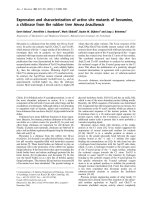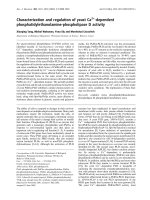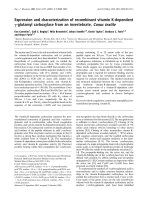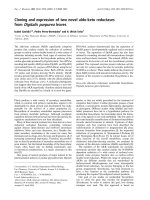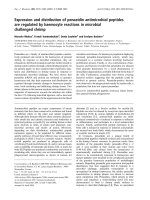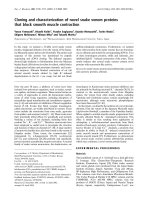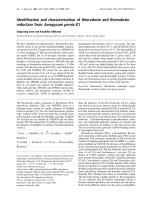Báo cáo y học: " Replication and transcription of human papillomavirus type 58 genome in Saccharomyces cerevisiae" pdf
Bạn đang xem bản rút gọn của tài liệu. Xem và tải ngay bản đầy đủ của tài liệu tại đây (2.58 MB, 8 trang )
RESEARC H Open Access
Replication and transcription of human
papillomavirus type 58 genome in Saccharomyces
cerevisiae
Jing Li
1
, Xiao Wang
2
, Juan Liu
1
, Hong Wang
1
, Xiao-Li Zhang
1
, Wei Tang
1
, Yun-Dong Sun
1
, Xin Wang
1
,
Xiu-Ping Yu
1
, Wei-Ming Zhao
1*
Abstract
Background: To establish a convenient system for the study of human papillomavirus (HPV), we inserted a
Saccharomyces cerevisiae selectable marker, Ura, into HPV58 genome and transformed it into yeast.
Results: HPV58 genome could replicate extrachromosomally in yeast, with transcription of its early and late gene s.
However, with mutation of the viral E2 gene, HPV58 genome lost its mitotic stability, and the transcription levels of
E6 and E7 genes were upregulated.
Conclusions: E2 protein could participate in viral genome maintenance, replication and transcription regul ation.
This yeast model could be used for the study of certain aspects of HPV life cycle.
Background
Human papillomaviruses are small circular DNA viruses
that infect epithelial cells and normally replicate as
nuclear plasmids. The life cycle of papillomavirus is
tightly linked to epithelial differentiation [1]. Among the
high-risk HPV types associated with cervical cancer,
human papillomavirus type 58 (HPV58) plays a more
prominent role in Asian countries. HPV58 has been
found in 5.9% of cervical cancer patients in China [2],
with an unusually high prevalence in cervical cancer
patients in specific areas of China: 33.3% in Hong Kong
[3] and 16.3% in Shanghai [4]. Despite the availability
for biological study of few cell lines containing the
DNA of high-risk HPVs such as 16, 18 and 31, no cell
lines or animal models containing HPV58 have been
established.
Saccharomyces cerevisiae is a species of budding yeast.
The cellular mechanism required for DNA replication in
S. cerevisiae is similar to that in human cells [5]. Studies
have shown yeast to be a versatile organism for the
study of viruses. Many types of DNA and RNA viruses,
including HPVs, can directly replicate in yeast [6].
Although HPV6, 16 and 31 can replicate stably in yeast
cells as nuclear plasmids [7,8], whether HPV58 genome
can replicate stably in yeast and whether the viral genes
can be transcribed in yeast are unknown.
In the present study, we first explored the replication
and transcription of HPV58 genome in the yeast system
and investigated the function of E2 on vrial DNA repli-
cation and transcription. We found that HPV58 genome
could replicate stably as a n episome, with transcription
of its early and late genes in yeast. However, with muta-
tion of the E2 gene, HPV58 genome lost its mitotic sta-
bility and the transcription levels of E6 and E7 genes
were upregulated. Thus, E2 protein can facilitate the
replication and maintenance of HPV58 DNA and regu-
late viral gene transcription in yeast cells.
Methods
DNA construction
HPV58-Ura
The Ura gene was amplified from S. cerevisiae plasmid
pRS316 with the sense (5’ -GATC
CACCGGTGGCA-
GATTGTACTGAGAGTG-3’) and anti-sense (5’-CTAG-
CACCG GTGTAGTATACATGCATTTAC-3’)primers
containing the SgrA I site (underlined). The PCR-pr o-
duced Ura wa s subcloned into the L2 open reading
frame (ORF) of pEGFPN1-HPV58 to construct a
* Correspondence:
1
Department of Medical Microbiology, Shandong University School of
Medicine, Jinan, Shandong, 250012, PR China
Full list of author information is available at the end of the article
Li et al. Virology Journal 2010, 7:368
/>© 2010 Li et al; licensee BioMed Central Ltd . This is an Open Access article distributed under the terms of the Creative Commons
Attribution License ( which permits unrestricted use, distribution, and reproduction in
any medium, provided the original work is properly cited.
pEGFPN1-HPV58-Ura plasmid. The HPV58-Ura was
released from pEGFPN1-HPV58-Ura by Bgl II digestion
and recircularized by T4 DNA ligase for yeast
transformation.
HPV58-Ura-E2 mutant (HPV58-Ura-E2mt)
A 1236 bp cassette was PCR amplified from pEGFPN1-
HPV58 with the sense (5’-C
CACCAGGTGTAATGAT-
GATTGGTAGCATC AAAGAC-3’) and anti-sense (5’ -
CATAC
CACCATG TGCAGAACCA-3’) primers contain-
ing the Dra III site (underlined) and three stop codons
(bold). The cassette was then substituted for th e Dra III
digested fragment (2924-4145 bp in HPV58 genome) in
the pEGFPN1-HPV58-Ura plasmid to construct a
pEGFPN1-HPV58-Ura-E2mt plasmid with three stop
codons (2927-2932 bp) in the E2 ORF (2753-3829 bp).
The HPV58-Ura-E2mt was released by Bgl II and recir-
cularized for transformation.
pDBLeu-E2
The E2 protein expression plasmid w as constructed as
follows: E2 ORF was PCR amplified with the sense pri-
mer (5’-CC
AAGCTTGAAAATTGGAAATCCT-3’)con-
taining the Hind III site (underlined) and anti-sense
primer (5’-CT
GCTAGCTTACAAGT CTTCTTCAGA-
GATCAACTTCTGTTCCAATGACATAACACCAG-
TACT-3’) containing the Nhe I site (underlined) and a
cMyc tag (bold). The E2 PCR product was subcloned
into pDBLeu to construct the pDBLeu-E2.
Yeast transformation
S. cerevisiae strain W303-1B (MATa leu2-3 leu2-112
trp1-1 ura3-1 his3-11 his3-15 ade2-1 can1-100)were
transformed w ith different sets of plasmids: 1). pRS316;
2). HPV58-Ura; 3). HPV58-Ura-E2mt; 4). HPV58-Ura-
E2mt and pDBLeu (HPV58-Ura-E2mt/pDBLeu); 5).
HPV58-Ura-E2mt and pDBLe u-E2 (HPV58-Ura-E2mt/
pDBLeu-E2). The transformed yeast were spotted on
selective medium plates for 3-5 days. Single colonies
were selected and cultured in yeast extract/peptone/dex-
trose (YPD) or synthetic complete (SC) dropout media
(Clontech) for further analysis.
Quantitative PCR (qPCR)
Yeast were cultured in 10 ml selective medium to an
OD600 of 1.0 and yeast DNA was isolated as described
[7]. The DNA was analysed by absolute qPCR with pri-
mers specific for E1 (sense: 5’ -CTGCAATGGAT-
GACCCTGAAG-3’ ; anti-sense: 5’ -CCACTATCGTCT -
GCTGTTTCGT-3 ’, amplicon: 136 bp, 878-1013 bp).
Yeast 18S rDNA was used as internal control (sense: 5’ -
TTGTGCTGGCGATGGTTCA-3’;anti-sense:5’ -TG-
CTGCCTTCCTTGGATGTG-3’, amplicon: 152 bp). A
standard curve was generated by amplification of a serial
dilution of pEGFPN1-HPV58-Ura.
Southern blot analysis
Yeast harboring HPV58-Ura and HPV58-Ura-E2mt/
pDBLeu-E2 were grown in 25-ml selective medium
overnight to yield an OD600 of 1.0. HPV58-Ura-E2mt
transformed yeast were cultured in 25 ml selective med-
ium for 3 days to yield an O D600 of 0.2, because of the
poor growth in selective medium. Yeast DNA was iso-
lated and digested with Xho I (no cut on HPV58 gen-
ome), Bgl II (1 cut), Hpa I(1cut)orDpn I(9cuts)for
24 hr. Dpn I can digest methylated DNA isolated from
bacteria only. The DNA was electrophoresed, blotted
onto nylon membrane (Roche) and probed with an L1
specific mRNA probe labeled with digoxigenin by in
vitro transcription according to the manufacturer’ s
instructions (DIG RNA Labeling Kit, Roche).
Western blot analysis
Yeast protein was prepared from yeast harboring
pDBLeu-E2, pDBLeu, and untransformed y east as pre-
viously described [9] P rotein samples were separated by
SDS-PAGE electrophoresis and transferred to nitrocellu-
lose membrane. Then the membrane was blocked with
3% BSA in PBST and immunoblotted with antibody
against cMyc (Santa Cruz). Membrane was washed and
incubated with HRP conjugated secondary antibody.
Chemilucent ECL Detection System (Millipore) was
used to detect the signals according to the manufac-
turer’s instruction.
HPV58 genome stability assay
The DNA stability assay was performed as previously
described [10]. Transformed yeast were first grown in
selective medium to mid-log phase and diluted to an
OD600 of 0.1 in new cultures containing non-selective
medium. The cultures were grown for 17 hr (10 cell
generations). The cultures at either 0 or 10 generations
were diluted to an OD600 of 0.1. Aliquots of 5 μlwere
spotted to selective and non-selective media. After 3
days of growth, the percentage of colonies containing
viral DNA was determined by t he ratio of the number
of colonies on selective medium to those on non-selec-
tive medium. The percentage of DNA loss per cell gen-
eration was calculated by subtracting the percentage
DNAretainedafter10generationsfromthatat0gen-
eration and divided by the total number of generations.
RNA extraction, RT-PCR and quantitative RT-PCR (qRT-
PCR)
Yeast were cultured in 10 ml selective medium to an
OD600 of 1.0 or 0.2 (HPV58-Ura-E2mt transformed
yeast). Yeast DNA and RNA were isolated from the
same samples. Yeast total RNA was isolated as
previously described [11] and digested by DNase I
Li et al. Virology Journal 2010, 7:368
/>Page 2 of 8
(Fermentas) to remove the contaminating D NA. PCR
involved use of DNase I-treated RNA as a template to
ensure the compl ete digestion of conta minating DNA in
RNA samples.
The DNase I treated RNA was analysed by RT-PCR
and absolute qRT-PCR with primers specific for E1
(sense: 5’ -CTGCAATGGATGACCCTGAAG-3’ ;anti-
sense: 5’-CCACTATCGTCTGCTGTTTCGT-3’,ampli-
con: 136 bp, 878-1013 bp), E2 (sense: 5’-GACAAAGC-
GACGACGACT-3’ ;anti-sense:5’-GTCGTTGTGTT
TCCGTTGT-3’ , amplico n: 335 bp, 3427 - 3761 bp), E6
(sense: 5’ -ACTATGTTCCAGGACGCAGAG-3’ ;anti-
sense: 5’-ACCTCAGATCGCT GCAAAG-3’,amplicon:
128 bp, 107-234 bp), E7 (sense: 5’ -GACGAGGAT-
GAAATAGGCTTG-3’ ;anti-sense:5’ -CGTCGGTTG
TTGTACTGTTGA-3’,amplicon:133bp,670-802bp),
L1 (sense: 5’ -CTTGAAATAGGTAGGGGACAG-3’ ;
anti-sense: 5’ -CAATGGAGGACAATCAGTAGC-3’ ,
amplicon: 249 bp, 5958-6206 bp) and L2 (sense : 5’-
CATAGTGACATATCGCCTGCTC-3’ ; anti-sense: 5’-
AGCCCCTATTTGCT TTCCAC-3’,amplicon:153bp,
5051-5203 bp) respectively. Standard curves were gener-
ated by amplification of a serial dilution of pEGFPN1-
HPV58-Ura.
Relative qRT-PCR was ued to compare the transcrip-
tion levels of E6 and E7 genes with or without E 2 pro-
tein. Because HPV58 genomes have different replication
efficiency in HPV58-Ura-, HPV58-Ura-E2mt- and
HPV58-Ura-E2mt/pDBLeuE2-transformed yeast, we first
compared the relative replication levels of the HPV58
genome in different transformants by qPCR. The E1 pri-
mers described previously and 18S rDNA primers
(sense:5’-TTGTGCTGGCGATGGTTCA-3’ ;anti-sense:
5’ -TGCTGCCTTCCTTGGATGTG -3’ , amplicon: 152
bp, as internal control) w ere used in qPCR. Then qRT-
PCR was performed to analyze the relative transcription
levels of E6 and E7 genes of HPV58-Ura, HPV58-Ura-
E2mt and HPV58-Ura-E2mt/pDBLeu-E2 in yeast, with
the 1 8S rRNA as internal control. The value of relative
transcription levels was divided by the value of DNA
relative replication levels to standardize the transcription
templates.
Results
Episomal replication of HPV58 in yeast
Viral DNA copy number was detected by qPCR from
five continuous yeast passages as sho wn in Table 1. The
viral DNA c opy number in per micro liter of yeast DNA
is relatively consistent in the five continous passages.
Averagely, there are 3-5 copies of viral DNA in per
yeast cell.
Southern blot was performed to investigate the repli-
cation form of HPV58 genome in yeast. As shown in
Figure 1A and 1B, when yeast DNA was treated with
Dpn I or restriction enzymes which have no recognition
site in HPV58 genome, the main form of HPV58 gen-
ome was open circular (OC). The vortex process during
yeast DNA isolation may disrupt the supercoiled plas-
mid (SC) and lead t o the formation of OC plasmid.
Yeast DNA digested by a single-cut restriction enzyme
revealed only a single band representing the linear form
of HPV58 (Figure 1A). Therefore, HPV58 genome could
replicate episomally in yeast.
Furthermore, no band was detected in the Dpn I trea-
ted DNA isolated from HPV58-Ura-E2mt transformed
yeast (Figure 1B, lane 1), which indicates that the E2
gene mutation induced instability and decreased the
replication level of viral DNA. Transformation of
pDBLeu-E2 into yeast restored the mitotic stability of
HPV58-Ura-E2mt and clear bands were detected (Figure
1B, lane 2-6). We have tried to detect and compare the
expression levels of E2 protein from HPV58-Ura and
pDBLeu-E2 with anti-HPV16 E2 antibody, but no bands
were detected. The transcription levels of E2 from
HPV58-Ura and pDBLeu-E2 were compared with qRT-
PCR, the mRNA level of E2 from pDBLeu-E2 is 323
folds to that from HPV58-Ura (Figure 1C). Furthermore,
we detected E2 protein in pDBLeu-E2 transformed yeast
with anti-cMyc antibody as shown in Figure 1D. There-
fore, E2 protein could facilitate viral genome replication
and maintenance.
Role of E2 protein in maintaining HPV58 genome in yeast
DNA stability assay was performed to investigate the
maintenance function of E2 protein on HPV58 genome.
The DNA loss per cell generation for HPV58-Ura (1.9%)
was comparable to that of the yeast plasmid pRS316
(2.1%) which contains centromeric elements (CEN) (Fig-
ure 2). Thus, the HPV58 genome was as stable as a
yeast CEN containing plasmid.
Yeast harboring HPV58-Ura-E2mt grew poorly in
selective medium, with no colony generated on the
selective plates at G0 and G10. However, with transfor-
mation of pDBLeu-E2 and re -expression of E2 protein
Table 1 HPV58 genome copy number in cotinuous 5
passages:
Passage viral DNA copies/μg yeast DNA*
P6 5.13×10
7
± 4.85×10
6
P7 4.09×10
7
± 3.38×10
6
P8 6.35×10
7
± 4.45×10
6
P9 5.93×10
7
± 2.14×10
6
P10 7.09×10
7
± 4.67×10
6
DNA was isolated from yeast culture from passage 5 to passage 10. Viral DNA
copies were quantitated by quantative PCR. The standard curve was
generated by serially diluted pEGFPN1-HPV58-Ura. There is 3-5 copies of viral
DNA in per yeast cells.
*Values are mean ± standard deviation.
Li et al. Virology Journal 2010, 7:368
/>Page 3 of 8
(Figure 1C, D), the HPV58 genome restored its mitotic
stability to a DNA loss rate of 2.5% per cell generation
(Figure 2). Therefore, E2 protein is critical to the mitotic
stability of the HPV58 genome in yeast.
Suppression of E6 and E7 transcription by E2 protein in
yeast
RT-PCR analysis re vealed the t ranscription of both early
(E1, E2, E6, E7) and late genes (L1 and L2) of HPV58-
Ura in yeast (Figure 3A). To further investigate the tran-
scription levels of viral genes in yeast cells, qRT-PCR
was performed separately with gene specific primers.
The results revealed that HPV58 early and late genes
have different transcription efficiency (Table 2).
To explore the regulatory function of E2 protein on
viral gene transcription, E6 a nd E7 genes transcription
levels in the three yeast transformant s were compared by
qRT-PCR. We first compared the DNA relative replica-
tion levels of HPV58 genome in yeast by qPCR. With the
relative replication level of HPV58-Ura s et to 1.0, DNA
relative replication levels were 0.03 for HPV58-Ura-E2mt
and 0.54 for HPV58-Ura-E2mt/pDBLeu-E2 (Figure 3B).
Then qRT-PCR was performed to compare the tran-
scription levels of E6 and E7 genes. Because wild type
HPV58 genome and E2 mutant HPV58 genome have
different replication levels, the relative transcription
levels were divided by the value of relative replication
levels. With E6 and E7 transcripion lev els of the
Figure 1 Replication of HPV 58 genome in S. cerevisiae. A and B:EpisomalreplicationofHPV58genomeinS. cerevisiae.YeastDNA
underwent Southern blot with an L1 specific mRNA probe. A, (DNA isolated from yeast harboring HPV58-Ura) Lane 1: yeast DNA without
enzyme digestion; lane 2-5: yeast DNA digested with Dpn I, Xho I, Bgl II and Hpa I. B, Lane 1: DNA isolated from HPV58-Ura-E2mt transformed
yeast and treated with Dpn I; lanes2-6 (yeast DNA isolated from HPV58-Ura-E2mt/pDBLeu-E2 transformed yeast), lane 2: DNA without enzyme
digestion; lanes 3-6: yeast DNA digested with Dpn I, Xho I, Bgl II and Hpa I separately. Arrows show the positions of open-circle (OC), linear (L)
and supercoiled (SC) forms of episomal HPV58-Ura or HPV58-Ura-E2mt. C. qRT-PCR to compare the E2 transcription levels in yeast cells harboring
HPV58-Ura or pDBLeu-E2. D. Expression of E2 protein in yeast. Yeast protein was prepared from yeast harboring pDBLeu-E2 (lane 1), pDBLeu
(lane 2), and untransformed yeast (lane 3).
Li et al. Virology Journal 2010, 7:368
/>Page 4 of 8
HPV58-Ura transformants set to 1.0, the relative tran-
scription levels of E 6 were 8.62 for HPV58-Ura-E2mt
and 1.02 for HPV58-Ura-E2mt/pDBLeu-E2. The E7 rela-
tive transcription levels were 1.96 for H PV58-Ura-E2mt
and 0.74 for HPV58-Ura-E2mt/pDBLeu-E2 (Figure 3C).
Therefore, E2 protein could suppress the E6 and E7
genes transc ription levels when HPV58 genom e persists
episomally in yeast.
Discussion
Previous reports have shown that HPV1, 6, 11, 16, 18
and 31 can replicate their genomes as episomal plasmids
in yeast. The genomes of HPV6, 16 and 31 are mitoti-
cally stable in yeast, howe ver HPV1, 11, and 18 are
unstable in yeast [7,8,12]. In the present study, we
showed that HPV58 genome, consist ent with the HPV6,
16 and 31, can replicate stably as an episomal plasmid
in yeast.
Stable maintenance through replication of extrachro-
mosomal DNA in yeast requires autonomous replication
sequences (ARS) [13,14], and centromeric elements
(CEN) [15]. There is a 10 of 11 nucleotide match to the
consensus core ARS sequence (CAS) (5’-[A/T]TTTAT
[A/G]TTT[A/T]-3’) in the HPV58 genome (accession
Figure 2 DNA stability assay of HPV 58 genome. Yeast containing different recombinant HPV58 genomes were grown under non-selective
conditions for 10 cell generations. After the incubation period, the cell cultures were serially diluted from 1 to 10
-5
. Equal volumes of each of
the dilutions were spotted onto selective (+) and non-selective (-) media. The percentage of DNA loss per cell generation was calculated by
subtracting the percentage DNA retained after 10 generations from that at 0 generation and divided by the total number of generations. Values
on the right are the means of three independent experiments. NA: non-available.
Li et al. Virology Journal 2010, 7:368
/>Page 5 of 8
no. D90400) at nucleotides 1225 to 1216. Yeast origin
recognition complex (ORC) may bind to the CAS-like
element and initiate viral genome replication. It has gen-
erally been thought that replication of papillomaviruses
is dependent upon the presence of E1, a DNA helicase,
and E2, a transcription and mainte nance factor [16,17].
E1 and E2 protein, perhaps in conjunction with CAS-
like elements, conduct the replication of HPV58 genome
in yeast.
Replication of genomes in yeast is a common feature
of HPVs. Different HPV types showed different genom e
stability in yeast cells. Two kinds of mechanisms may
control the mitotic stability of the HPV58 genomes i n
yeast. First, HPV58 sequences may contain cis-elements
that can substitute for the CEN required for the mainte-
nance of e xtrochromosomal DNA in S. cerevisiae .The
second mechanism may be the function of HPV58 E2
protein, a maintenance protein that can tether viral gen-
omes to mitotic chromosomes in dividing cells [18,19].
Angeletti et al. (2002) repor ted that the HPV16 genome
can replicate stably in yeast cells with the E2 gene inter-
rupted by introducing stop codons. Kim et al (2005)
also identified the CEN-like cis-elements in the HPV16
genome in yeast and mammalian cells and conc luded
that the maintenance of the HPV16 genome depends on
the CEN-like cis-elements, perhaps in conjunction with
E2 protein. HPV16 can maint ain the mitotic stability o f
its genome in an E2-independent manner in yeast and
mammalian cells [7,20,21].
In contrast to HPV16 genome, the maintenance of
HPV58 genome depends on E2 protein. The wild-type
HPV58 genome can replicate stably in transformed
yeast cells. However, with the HPV58 E2 gene inter-
rupted by mutation, HPV58-Ura-E2mt genome was
unstable in yeast. Introduction of pDBLeu-E2 and re-
expression of E2 protein restored the stability of
HPV58-Ura-E2mt genome in yeast cells. Therefore, the
maintenance and faithful segregation of HPV58 genome
dependsonE2protein.TheHPV58genomehasno
CEN-like cis-elements. This specific maintenance pat-
tern of the HPV58 genome may provide a possible way
to interfere with the early stage of HPV58 infection by
blocking the expression of E2 protein.
Previous reports of the HPV/yeast system focused on
the replication of HPV DNA. In fact, the HPV/yeast sys-
tem could be a model for the study of HPV gene tran-
scription. Although we failed to detect the mRNA of
HPV58 early and late genes by Northern blot, which
may be due to the low transcription levels of viral genes
Figure 3 Transcription of HPV58 genes in S. cerevisiae. A.RT-
PCR analysis of transcriptional expression of HPV58 early and late
genes in the HPV58-Ura transformed yeast. E1 (lanes 1, 2), E2 (lanes
3, 4), E6 (lanes 5, 6), E7 (lanes 7, 8), L1 (lanes 9, 10) and L2 (lanes 11,
12) from the cDNA samples. Total RNA was isolated from HPV58-Ura
transformed yeast and digested with DNase I. The DNase I treated
RNA was amplified to ensure the complete digestion of
contaminating viral DNA (lanes 2, 4, 6, 8, 10 and 12). DNase I
completely digested RNA were then analysized by RT-PCR (lanes 1,
3, 5, 7, 9 and 11). B. Relative replication levels of HPV58 genomes in
HPV58-Ura, HPV58-Ura-E2mt and HPV58-Ura-E2mt/pDBLeu-E2
transformed yeast. 18S rDNA was used as internal control. The DNA
relative replication levels of HPV58-Ura-E2mt (0.03) and HPV58-Ura-
E2mt/pDBLeu-E2 (0.54) are relative to that of HPV58-Ura, which was
set to 1.0. Standard deviations are indicated by error bars. C.
Relative transcription levels of E6 and E7 genes for HPV58-Ura,
HPV58-Ura-E2mt and HPV58-Ura-E2mt/pDBLeu-E2. DNase I treated
RNA was analysized by qRT-PCR with 18S rRNA as internal control.
As for HPV58 genomes have different replication efficiency in the
presence or absence of E2 protein (Figure 3B), the transcription
levels of E6 and E7 genes were then standardized to the relative
DNA replication assay. The E6 and E7 genes transcriptional levels of
HPV58-Ura were set to 1.0. The transcription levels of E6 are 8.62 for
HPV58-Ura-E2mt and 1.02 for HPV58-Ura-E2mt/pDBLeu-E2. The E7
transcription levels are 1.96 for HPV58-Ura-E2mt and 0.74 for HPV58-
Ura-E2mt/pDB Leu-E2 relative to that of HPV58-Ura, which was set
to 1.0. Standard deviations are indicated by error bars.
Table 2 Transcription levels of HPV58 genes in yeast
Gene mRNA Copies/μg total RNA*
E1 6.54×10
5
± 1.03×10
4
E2 2.42×10
4
± 1.83×10
3
E6 2.48×10
4
± 1.77×10
3
E7 3.75×10
5
± 2.68×10
4
L1 2.08×10
5
± 1.73×10
4
L2 1.34×10
6
± 1.24×10
4
Note: Total RNA isolated from yeast cells were digested with DNase I and
converted into cDNAs by reverse transcription. The standard curve was
generated by serially diluted pEGFPN1-HPV58-Ura. The levels of the viral gene
transcripts examined in per microgram total RNA were analyzed by qRT-PCR.
*Values are mean ± standard deviation.
Li et al. Virology Journal 2010, 7:368
/>Page 6 of 8
in yeast. RT-PCR results revealed the transcription of
HPV58 early and late genes in yeast. Moreover, qRT-
PCR analysis of transcription regulation function of E2
protein revealed both E6 and E7 mRNA levels were
upregula ted with HPV58-Ura-E2mt introduced into
yeast. However, with re-expression of E2 protein, the
mRNA levels were downregulated. These results confirm
that E2 protein can supp ress E6 and E7 genes transcrip-
tion when HPV58 genome persists episomally in yeast.
Bechold et al (2003) reported that E2 protein had no
affect on E6/E7 expression in mammalial cells [22]. Bou-
vard et al (1994) reported that HPV16 and 18 E2 pro-
tein could activate their early promoter in CAT
luciferase reporter plasmid. However, overexpression of
E2 repressesd the early promoter [23]. These reports are
different from our data that E2 protein repressed early
promoter transcription in yeast. The reasons should be
the different cell lines used, different expression levels of
E2 protein and different conformation of viral minichro-
mosomes in cells, especially the chromatin conformation
of long control region (LCR).
The early promoter of HPV locates in the LCR of the
viral genome [24]. The LCR has four E2 protein binding
sites (E2BS). E2BS4 is far from the TATA box. The
other t hree E2BS (E2BS1, E2BS2 and E2BS3) are proxi-
mal to the TATA box. E2 protein binding to E2BS4,
which is far from TATA box, stimulates the transcrip-
tion level of E6 and E7. However, binding of E2 protein
to the other three E2BS represses transcription through
steric hindrance o f the interaction with the transcrip-
tional initiation factor TFIID at the proximal TATA box
[25,26]. Binding of E2 protein to a specific E2BS is
determined by the genome status. HPV58 E2 protein
might interact with the E2BS proximal t o the TATA
box when the HPV58 genome is maintained as an episo-
mal plasmid in yeast.
Conclusions
The HPV58/yeast system we used was able to direct the
stable replication of the HPV58 genome and induce the
transcription of the early and late genes. As compared
with maintenance of the HPV16 genome, HPV58 gen-
ome strictly depends on E2 protein. E2 protein can
supress the transcription of E 6 and E7 genes. With its
ease of handling and similarity to mammalian system,
the yeast system we described is useful for future study
of HPV58 genome replication and the regulatory
mechanism of viral gene transcription.
List of abbreviations
ARS: autonomously replicating sequences; CEN: centromer ic elements; HPV:
Human papillomavirus; LCR: long control region; qPCR: quantitative PCR;
qRT-PCR: quantitative RT-PCR; RT-PCR: reverse transcription PCR;
Competing interests
The authors declare that they have no competing interests.
Authors’ contributions
JL constructed the HPV58-Ura-E2mt, pDBLeu-E2, participated in Sountern
blot, Northern blot, Western blot, DNA stability assay and drafted the
manuscript. XW constructed HPV58-Ura, participated in Western blot, DNA
stability assay and PCR. JL and HW participated in Southern blot and DNA
stability assay. XLZ participated in yeast transformation and DNA stability
assay. WT and YDS helped to perform the real time quantitative PCR,
Southern blot and Northern blot. XW participated in primers and probe
design. XPY gave advices on the design of this study. WMZ designed the
study and drafted the manuscript. All authors read and approved the final
manuscript.
Acknowledgements
This work was funded by the National Natural Science Foundation of China
(30470086 to WMZ). We thank Dr. Kong-Nan Zhao (University of Queensland
Centre for Clinical Research, Australia) and Dr. Peter Angeletti (University of
Nebraska-Lincoln School of Life Science) for their guidance on the
experiments.
Author details
1
Department of Medical Microbiology, Shandong University School of
Medicine, Jinan, Shandong, 250012, PR China.
2
Department of Pathology,
Shandong University School of Medicine, Jinan, Shandong, 250012, PR China.
Received: 25 July 2010 Accepted: 15 December 2010
Published: 15 December 2010
References
1. Doorbar J: The papillomavirus life cycle. J Clin Virol 2005, 32:7-15.
2. Wu Y, Chen Y, Li L, Yu G, Zhang Y, He Y: Associations of high-risk HPV
types and viral load with cervical cancer in China. J Clin Virol 2005,
35:264-269.
3. Chan PK, Cheung TH, Li WW, Lo KW, Chan MY, Cheung JL, Cheng AF:
Association of Human Papillomavirus Type 58 Variant With the Risk of
Cervical Cancer. J Natl Cancer Inst 2002, 94:1249-1253.
4. Liaw KL, Hsing AW, Schiffman MH, You SL, Zhang T, Burk R, Chen CJ:
Human papillomavirus types 52 and 58 are prevalent in cervical cancers
from Chinese women. Int J Cancer 1997, 73:775-776.
5. Bielinsky AK, Gerbi SA: Where it all starts: eukaryotic origins of DNA
replication. J Cell Sci 2001, 114:643-651.
6. Alves-Rodrigues I, Galão RP, Meyerhans A, Díez J: Saccharomyces
cerevisiae: A useful model host to study fundamental biology of viral
replication. Virus Research 2006, 120:49-56.
7. Angeletti PC, Kim K, Fernandez FJ, Lambert PF: Stable replication of
papillomavirus genomes in Saccharomyces cerevisiae. J Virol 2002,
76:3350-3358.
8. Chattopadhyay A, Schmidt MC, Khan SA: Identification of a 450-bp region
of human papillomavirus type 1 that promotes episomal replication in
Saccharomyces cerevisiae. Virology 2005, 340:133-142.
9. Kushinirov VV: Rapid and reliable protein extraction from yeast. Yeast
2000, 16:857-860.
10. Kapoor P, Shire K, Frappier L: Reconstitution of Epstein-Barr virus-based
plasmid partitioning in budding yeast. EMBO J 2001, 20:222-230.
11. Li J, Liu J, Wang X, Zhao L, Chen Q, Zhao WM: A water bath method for
preparation of RNA from Saccharomyces cerevisiae. Analy Bioch 2009,
384:189-190.
12. Rogers AJ, Loggen M, Lee K, Angeletti PC: Varying efficiency of long term
replication of papillomaviruses in Saccharomyces cerevisiae. Virology
2008, 381:6-10.
13. Hsiao CL, Carbon J: High-frequency transformation of yeast by plasmids
containing the cloned yeast. ARG4 gene. Proc Natl Acad Sci 1979,
76:3829-3833.
14. Stinchcomb DT, Struhl K, Davis RW: Isolation and characterisation of a
yeast chromosomal replicator. Nature 1979, 282:39-43.
15. Maraherns Y, Stillman B: A yeast chromosomal origin of DNA replication
defined by multiple functional elements. Science 1992, 255:817-823.
Li et al. Virology Journal 2010, 7:368
/>Page 7 of 8
16. Rabson MS, Yee C, Yang YC, Howley PM: Bovine papillomavirus type 1 3’
early region transformation and plasmid maintenance functions. J Virol
1986, 60:626-634.
17. Ustav M, Ustav E, Szymanski P, Stenlund A: Identification of the origin of
replication of bovine papillomavirus and characterization of the viral
origin recognition factor E1. EMBO J 1991, 10:4321-4329.
18. Abroi A, Ilves I, Kivi S, Ustav M: Analysis of chromatin attachment and
partitioning functions of bovine papillomavirus type 1 E2 protein. J Virol
2004, 78:2100-2113.
19. Lehman CW, King DS, Botchan MR: A papillomavirus E2 phosphorylation
mutant exhibits normal transient replication and transcription but is
defective in transformation and plasmid retention. J Virol 1997,
71:3652-3665.
20. Kim K, Angeletti PC, Hassebroek EC, Lambert PF: Identification of cis-Acting
Elements That Mediate the Replication and Maintenance of Human
Papillomavirus Type 16 genomes in Saccharomyces cerevisiae. J Virol
2005, 79:5933-5942.
21. Pittayakhajonwut D, Angeletti PC: Analysis of cis-elements that facilitate
extrachromosomal persistence of human papillomavirus genomes.
Virology 2008, 374:304-314.
22. Bechtold V, Beard P, Raj K: Human Papillomavirus Type 16 E2 Protein Has
No Effect on transcription from episomal viral DNA. J Virol 2003,
77:2012-2028.
23. Bouvard V, Storey A, Pim D, Banks L: Characterization of the human
papillomavirus E2 protein: evidence of trans-activation and trans-
repression in cervical keratinocytes. EMBO J 1994, 13:5451-5459.
24. Rosenstierne MW, Vinther J, Hansen CN, Prydsoe M, Norrild B: Identification
and characterization of a cluster of transcription start sites located in
the E6 ORF of human papillomavirus type 16. J Gen Virol 2003,
84:2909-2920.
25. Demeret C, Desaintes C, Yaniv M, Thierry F: Different mechanisms
contribute to the E2-mediated transcriptional repression of human
papillomavirus type18 viral oncogenes. J Virol 1997, 71:9343-9349.
26. Sanchez IE, Dellarole M, Gaston K, de Prat Gay G: Comprehensive
comparison of the interaction of the E2 master regulator with its
cognate target DNA sites in 73 human papillomavirus types by
sequence statistics. Nucleic Acids Res 2008, 36:756-769.
doi:10.1186/1743-422X-7-368
Cite this article as: Li et al.: Replication and transcription of human
papillomavirus type 58 genome in Saccharomyces cerevisiae. Virology
Journal 2010 7:368.
Submit your next manuscript to BioMed Central
and take full advantage of:
• Convenient online submission
• Thorough peer review
• No space constraints or color figure charges
• Immediate publication on acceptance
• Inclusion in PubMed, CAS, Scopus and Google Scholar
• Research which is freely available for redistribution
Submit your manuscript at
www.biomedcentral.com/submit
Li et al. Virology Journal 2010, 7:368
/>Page 8 of 8
